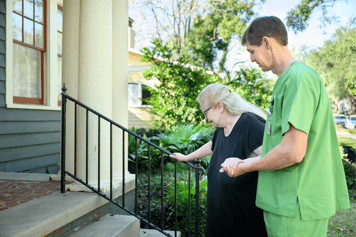If you’re seeking care at home to help manage chronic health conditions, mobility challenges and more, it can be confusing to understand what to expect in terms of cost. However, there are ways to understand the financial implications of in-home care and make informed decisions tailored to your situation. Read on to learn more about the differences between home care, home health and the cost of these services.
Home Care vs. Home Health Care
These two terms sound very alike and are often thought to mean the same thing. However, there are key differences between home care and home health care:
Home Care
Home care is help with daily activities like bathing, toileting, housekeeping and meal preparation. Home care is also sometimes called personal care, companion care, custodial care or homemaker services. It is non-medical care.
Home Health Care
Home health care is medical care provided at home for eligible patients to treat a chronic health condition or help you recover from illness, injury or surgery. It is often used after a stay in the hospital or a skilled nursing facility, but sometimes it is also started to help treat newly diagnosed medical conditions or a decline in health from a chronic health condition.
Understanding Home Health Cost
Home health care offers several health care services that you can get in your home for an illness or injury. Eligible patients can receive care that is covered by Medicare or in some cases, private insurance or Medicaid.
How Home Health Care is Covered by Medicare
Medicare Part A or Part B may cover your home health care if you need part-time or intermittent care. It is not long-term or around-the-clock care.
Covered home health services include:
- Medically necessary part-time or intermittent skilled nursing care, like:
- Wound care for pressure sores or a surgical wound
- Patient and caregiver education
- Intravenous or nutrition therapy and injections
- Catheter and ostomy care
- Medication management
- Pain management
- Monitoring serious illness and unstable health status
- Physical therapy
- Occupational therapy
- Speech-language pathology services
- Medical social services
- Part-time or intermittent home health aide care (only if you’re also getting skilled nursing care, physical therapy, speech-language pathology services, or occupational therapy), like:
- Help with walking
- Bathing or grooming
- Changing bed linens
- Feeding
It’s important to note that Medicare does not cover long-term care or services such as:
- 24/7 care at home or long-term care
- Home meal delivery
- Help with getting dressed, bathing and using the bathroom
- Help with cleaning, cooking, laundry, running errands and other homemaker services
Medicare may not cover 100% of the cost of home health if:
- Your doctor recommends services Medicare doesn’t cover.
- Your doctor recommends you get services more often than Medicare covers.
Your home health agency can provide a clear explanation of any out-of-pocket costs in advance, so you’ll know what to expect before care begins.
Understanding Home Care Cost
Unlike home health care, home care services are usually not covered by traditional health insurance. Most in-home care services are based on an hourly rate and have a wide range of potential figures depending on the location, care provided and the type of care needed. These costs may be covered by long-term care insurance, which must be purchased separately. 1
Location-Based Pricing
The nationwide median cost of home care in 2024 was $33 per hour. 2 However, cost of living, geography and specific state regulations can affect the cost in each state. In areas like Louisiana, where costs of living are much lower and there is access to more available professionals, the average hourly rate is about $25 per hour. States where cost of living is higher, such as California, New York and Massachusetts, tend to have higher home care rates.
Level of Care Needed
The costs can vary based on how many hours per day or week you require services. Around-the-clock care will cost more than care provided for just a few hours each day— as much as $19,656 per month or more. 3
Duration and Frequency of Visits
The total cost of home care services is directly affected by how often and how long visits occur. More frequent or extended visits will naturally lead to higher overall expenses.
For instance, receiving three hours of care daily, five days a week, will cost considerably more than one hour of care three times a week.
Ways to Reduce and Manage the Cost of Care
Managing home care costs can feel overwhelming, but there are practical steps you can take to reduce expenses while still ensuring quality care.
Review Insurance Coverage and Eligibility
Take time to thoroughly examine your insurance plan to understand which services are covered. Pay close attention to out-of-pocket expenses such as deductibles, copayments and coinsurance. Remember, if you or a loved one is eligible for home health care, these expenses may be covered by insurance.
Develop a Budget
Once you’ve determined if you or your loved one need home health care alongside home care, you can create a budget that aligns with your loved one’s care needs and your financial situation. Prioritize focusing on essential services and identify potential daily tasks that can be safely handled by family members or friends to help cut non-medical costs that are not covered by insurance.
Consider Community Resources
Many communities offer valuable programs to help older adults live safely at home. These may include meal delivery, transportation, respite care and assistance with home modifications or medical equipment. Home health care medical social workers can help you identify resources in your area.
We understand managing the costs of home care can be overwhelming, but Amedisys is here to guide you through the home health care process.
Speak with a member of our care team today.
Carolyn Hartsfield, MBA, RN, serves as Assistant Vice President of Nursing Strategy Innovation Programs at Amedisys. With 30 years of nursing experience, including 28 years in the home health industry, Carolyn brings a wealth of expertise to the field. She is passionate about improving home health services and dedicated to making a lasting impact in the industry.
References |





